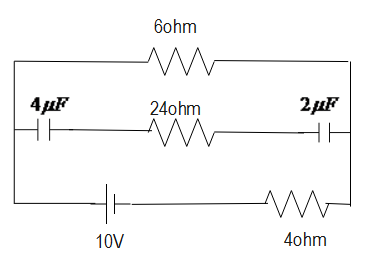
: The charge developed on $4\mu F$ condenser is:


Answer
559.5k+ views
Hint: In this question, we will use the relation between the charge, capacitance and voltage. Also, by substituting the given values we will get the required result. Further, we will study the basics of a simple electric circuit.
Formula used:
$Q = CV$
Complete answer:
We know that the electrical charge of a circuit or device is defined as the capacitance times the voltage of a given circuit.
We know, from the ohm’s law:
$I = \dfrac{V}{R}$
By putting the values in above equation, we get:
$I = 1A$
Potential difference developed across $4\mu F$ condenser in the circuit:
$P.D = 2.5 - (0.5 \times 1)$
$ \Rightarrow P.D = 2V$
Now, the charge developed is given by:
$Q = CV$
Now, by substituting the values in the above equation, we get:
$\eqalign{& Q = 4 \times 2 \cr
& \therefore Q = 8\mu C \cr} $
Therefore, we get the required result, which tells us the charge developed on the given condenser.
Additional information:
We should know that in a series circuit, the output current of the first resistor flows into the input of the second resistor; so, the current is the same in each resistor whereas In a parallel circuit, all of the resistor are on connected together on one side and all the leads on the other side are connected together.
In a circuit if the resistance is constant over a range of voltage, then I = V/R, can be used to predict the behavior of the material. This involves DC current and voltage, it is the same for the resistors. Further, a material obeys Ohm's law or does not obey; the resistance of the material can be described in terms of its bulk. The resistivity, and the resistance both, is temperature dependent. Over certain ranges of temperature, this temperature dependence can be predicted from resistance.
Note:
In series connection the resistances are directly added whereas in parallel connection resistance is added inversely. Internal resistance of a circuit refers to the opposition to the flow of current offered by the cells and batteries themselves thereby, resulting in the generation of heat. Internal resistance and resistance both are measured in Ohms.
Formula used:
$Q = CV$
Complete answer:
We know that the electrical charge of a circuit or device is defined as the capacitance times the voltage of a given circuit.
We know, from the ohm’s law:
$I = \dfrac{V}{R}$
By putting the values in above equation, we get:
$I = 1A$
Potential difference developed across $4\mu F$ condenser in the circuit:
$P.D = 2.5 - (0.5 \times 1)$
$ \Rightarrow P.D = 2V$
Now, the charge developed is given by:
$Q = CV$
Now, by substituting the values in the above equation, we get:
$\eqalign{& Q = 4 \times 2 \cr
& \therefore Q = 8\mu C \cr} $
Therefore, we get the required result, which tells us the charge developed on the given condenser.
Additional information:
We should know that in a series circuit, the output current of the first resistor flows into the input of the second resistor; so, the current is the same in each resistor whereas In a parallel circuit, all of the resistor are on connected together on one side and all the leads on the other side are connected together.
In a circuit if the resistance is constant over a range of voltage, then I = V/R, can be used to predict the behavior of the material. This involves DC current and voltage, it is the same for the resistors. Further, a material obeys Ohm's law or does not obey; the resistance of the material can be described in terms of its bulk. The resistivity, and the resistance both, is temperature dependent. Over certain ranges of temperature, this temperature dependence can be predicted from resistance.
Note:
In series connection the resistances are directly added whereas in parallel connection resistance is added inversely. Internal resistance of a circuit refers to the opposition to the flow of current offered by the cells and batteries themselves thereby, resulting in the generation of heat. Internal resistance and resistance both are measured in Ohms.
Recently Updated Pages
Master Class 12 Business Studies: Engaging Questions & Answers for Success

Master Class 12 Economics: Engaging Questions & Answers for Success

Master Class 12 English: Engaging Questions & Answers for Success

Master Class 12 Maths: Engaging Questions & Answers for Success

Master Class 12 Social Science: Engaging Questions & Answers for Success

Master Class 12 Chemistry: Engaging Questions & Answers for Success

Trending doubts
What are the major means of transport Explain each class 12 social science CBSE

Which are the Top 10 Largest Countries of the World?

Draw a labelled sketch of the human eye class 12 physics CBSE

Explain sex determination in humans with line diag class 12 biology CBSE

The pH of the pancreatic juice is A 64 B 86 C 120 D class 12 biology CBSE

Explain sex determination in humans with the help of class 12 biology CBSE




